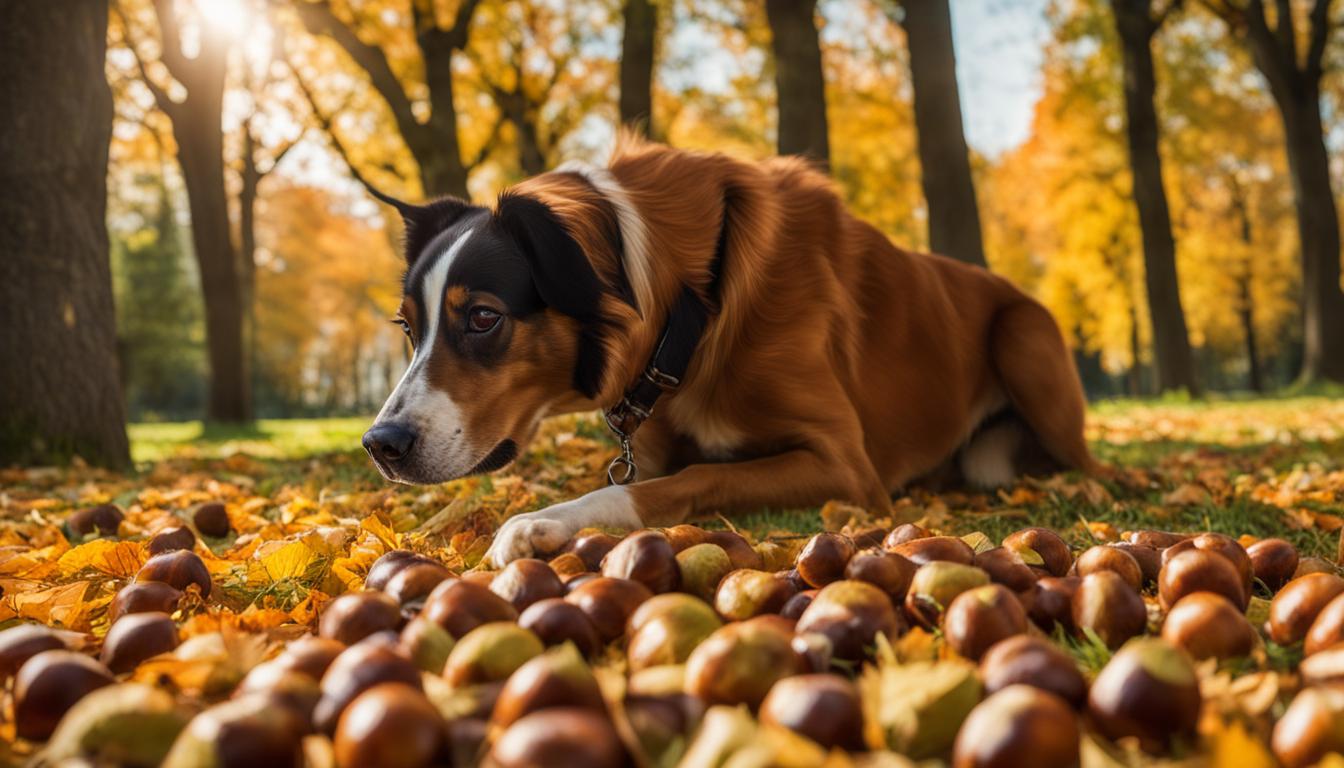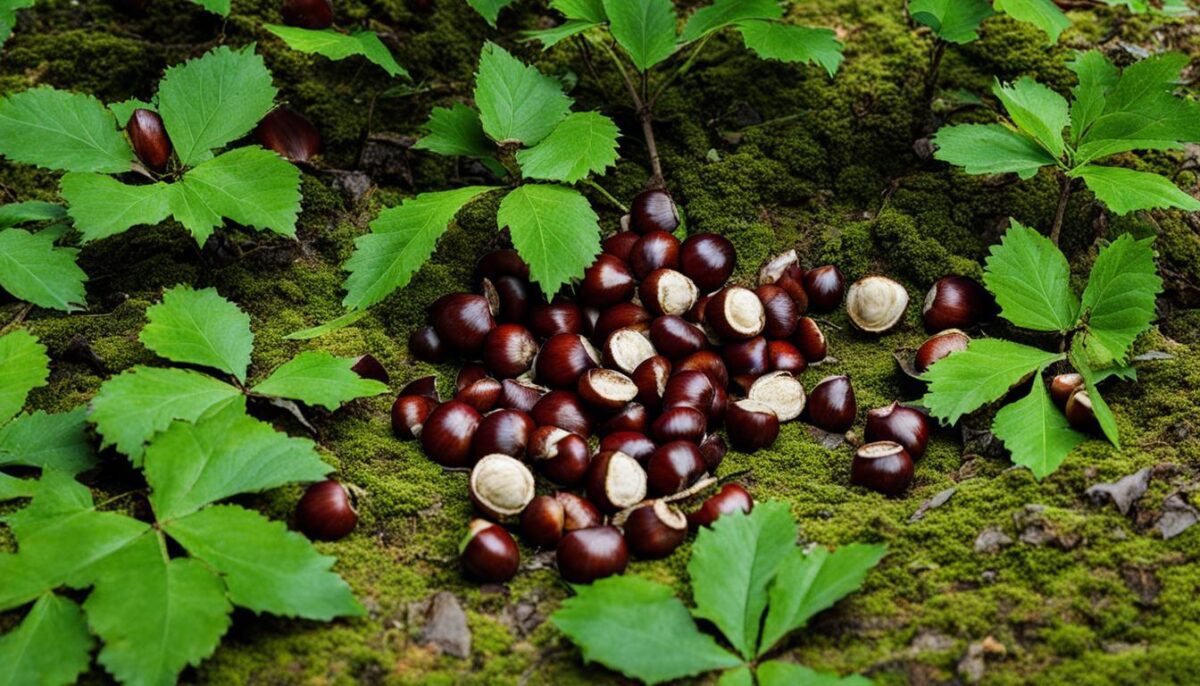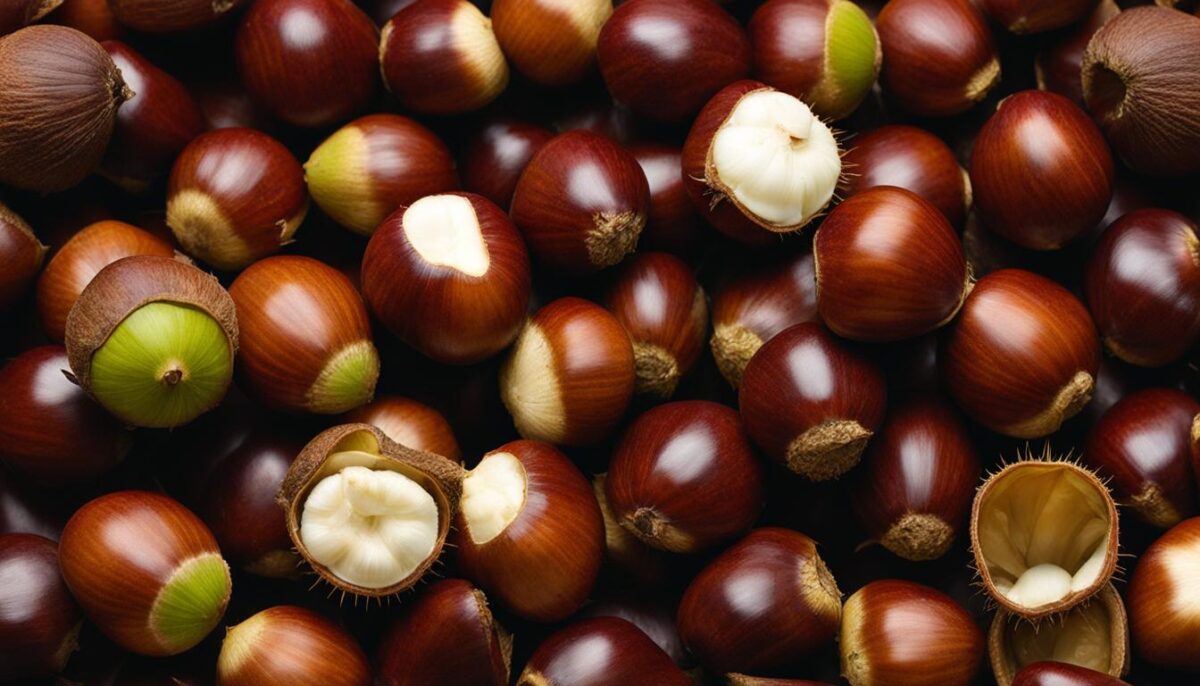As a dog owner, it’s crucial to know what foods are safe for your furry friend. One common question is whether dogs can eat horse chestnuts, also known as conkers. These nuts can be found on the ground during autumn and might look like a tasty treat to your pet. However, they can be dangerous for your dog due to their toxicity.
Horse chestnuts contain a harmful chemical called aesculin, which can cause serious illness in dogs when ingested. Even small amounts can damage their nerve tissues and red blood cells. To keep your dog safe from aesculin poisoning, it’s vital to prevent them from consuming horse chestnuts and seek immediate vet advice if you suspect they’ve eaten one.
Key Takeaways
- Horse chestnuts are toxic to dogs due to the presence of aesculin.
- Aesculin poisoning can cause severe illness, including nerve damage and red blood cell rupture.
- Symptoms of horse chestnut poisoning include muscle twitching, seizures, and difficulty breathing.
- Immediate veterinary care is essential if your dog consumes a horse chestnut.
- During autumn, ensure your dog avoids eating fallen horse chestnuts to prevent potential harm.
The Dangers of Horse Chestnuts to Dogs
The ingestion of horse chestnuts, also known as conkers, poses a serious threat to dogs due to a toxic compound called aesculin. This compound can harm a dog’s nervous system and red blood cells, leading to a range of severe symptoms. By understanding the dangers of horse chestnuts and knowing what to look for in cases of canine toxicity, dog owners can provide timely emergency dog care and reduce the risk of conker hazards harming their pets.
The Toxicity of Aesculin in Horse Chestnuts
Aesculin, the toxic substance found in horse chestnuts, can severely affect a dog’s nerves and red blood cells. When ingested, even small amounts of this toxin can cause symptoms that range from mild gastrointestinal issues to life-threatening shock and organ failure. To protect their dogs from these canine toxicity risks, owners should always be aware of the potential dangers associated with horse chestnuts and conkers.
Recognizing Symptoms of Poisoning in Dogs
If a dog consumes horse chestnuts or any part of the horse chestnut tree, it is essential to be familiar with the signs of poisoning to act quickly and seek prompt veterinary care. Symptoms may include restlessness, abdominal pain, vomiting, toxic shock, and respiratory changes. Dogs may exhibit signs of intoxication anywhere from 1 to 6 hours or as late as 2 days after consuming the toxic plant components.
Immediate Actions When Suspecting Poisoning
When a dog is suspected of ingesting horse chestnuts or their tree parts, owners should not delay in seeking veterinary advice, as emergency dog care is crucial. Treatment options offered by a veterinarian may include intravenous hydration, induced vomiting, or even surgery to remove blockages caused by conker ingestion. As there is no known antidote for aesculin poisoning, prevention and swift action following exposure are essential for minimizing the risks associated with this potentially deadly toxin.
Understanding Horse Chestnuts and Conkers
To ensure the safety of your dogs, it is essential to be able to identify conkers (horse chestnuts) and be aware of the toxic plants for dogs. Conkers grow on horse chestnut trees, which are easily found in parks and woodlands. In the UK, these trees usually drop their seeds, including conkers, from September onwards. However, this may happen earlier during hotter summers.
It’s crucial to distinguish between horse chestnuts and sweet chestnuts, as the latter is safe for dogs to consume. Horse chestnuts are larger and rounder than sweet chestnuts. The casing of horse chestnuts has wide-spaced and thicker spikes compared to the tightly packed thin spikes on sweet chestnut casings.
Horse chestnuts and sweet chestnuts may seem similar at first glance, but proper identification can prevent dogs from ingesting toxic plants.
The timing of conker dropping from horse chestnut trees not only helps pet owners stay vigilant but also provides valuable data for scientists studying climate change effects. As conker dropping is influenced by weather patterns, it serves as an indirect indicator of climate shifts.
To help you with conkers identification and differentiate them from other chestnuts, refer to the table below:
| Feature | Horse Chestnuts (Conkers) | Sweet Chestnuts |
|---|---|---|
| Shape | Round | Smaller, tapers at the bottom |
| Size | Larger | Smaller |
| Casing Spikes | Wide-spaced, thicker spikes | Tightly packed thin spikes |
| Toxicity | Toxic for dogs | Safe for dogs |
In conclusion, proper conkers identification is critical for protecting your dogs from ingesting toxic plants. Please remain vigilant during autumn months when horse chestnuts fall, especially in areas where horse chestnut trees are common.
Can Dogs Eat Horse Chestnuts?
Dogs cannot safely consume horse chestnuts or any part of the horse chestnut tree due to the presence of the toxic substance aesculin. This compound is found throughout the horse chestnut tree, including its leaves, bark, and flowers, making them all hazardous to canines. Despite the natural curiosity dogs may have, there are some misconceptions about the safety of natural items for dogs to eat, and horse chestnuts are among those with potential dietary risks.
Why Eating Horse Chestnuts Is Risky for Dogs
The consumption of horse chestnuts can cause significant food safety issues for dogs on account of the aesculin that is found within these nuts. Aesculin is harmful to dogs and can lead to gastrointestinal upset, nerve damage, and potentially fatal reactions. Since harmful nuts for dogs like horse chestnuts can cause considerable distress, it is vital for dog owners to prevent their pets from consuming them.
Misconceptions About Dogs and Natural Foods
Many dog owners believe that naturally occurring items like conkers are safe for dogs to ingest, but this is a dangerous misconception. Although many natural items do not pose a threat to dogs, horse chestnuts and other toxic nuts can indeed cause severe health issues. This underscores the importance of being mindful of the dietary risks which certain natural items may present to our canine companions.
Identifying Horse Chestnuts vs. Other Varieties
As a responsible dog owner, it’s crucial to know how to distinguish toxic nuts from safe ones. Horse chestnuts and sweet chestnuts are often confused, but they pose vastly different risks for your furry friend. Learning the key differences in their appearance helps ensure your dog stays safe.
Horse chestnuts are larger and rounder, with a darker brown hue. Their green casing has wide-spaced, thicker spikes. In contrast, sweet chestnuts are smaller, flat on one side, and their green casing features tightly packed thin spikes. The following table outlines the main differences between these two nut varieties:
| Horse Chestnuts | Sweet Chestnuts |
|---|---|
| Larger and rounder | Smaller and flat on one side |
| Darker brown hue | Lighter brown hue |
| Wide-spaced, thicker spikes on casing | Tightly packed thin spikes on casing |
| Contain aesculin, unsafe for dogs | Non-toxic, safe chestnuts for dogs |
It’s essential to remember that horse chestnuts contain aesculin, making them dangerous for your dog to consume. In stark contrast, sweet chestnuts pose no risk and can be safely eaten by both humans and dogs. By understanding these key differences, you can keep your canine companion protected from the potential dangers of toxic nuts.
Treatment Options for Horse Chestnut Poisoning
When a dog is suspected of ingesting horse chestnuts, it is crucial to seek immediate veterinary care for proper assessment and diagnosis. Since there is no cure for aesculin toxicity, veterinarians will prioritize stabilizing the pet and providing supportive care to help them recover from the potential effects of poisoning.
Assessment and Diagnosis by a Veterinarian
Your vet will carefully examine your dog for symptoms of horse chestnut poisoning and may perform tests to confirm the diagnosis. This process enables them to understand the severity of the situation and determine the best course of action for your dog’s unique needs. Prompt diagnosis and intervention are crucial in managing horse chestnut toxicity in dogs.
Possible Treatments and Recovery Procedures
Once your dog has been diagnosed with horse chestnut poisoning, the veterinary care team will initiate treatments aimed at providing supportive care and managing symptoms. Treatments may include administering an intravenous drip to combat dehydration, especially after vomiting or diarrhea, and possibly medications to induce emesis or gastric lavage. In severe cases, surgery might be necessary to remove conker pieces causing blockages.
Recovery from mild symptoms usually occurs within a day, but it could take days in more severe cases, with fatal outcomes being infrequent but possible. Meticulous monitoring and immediate veterinary intervention are key elements in managing horse chestnut toxicity in dogs, ensuring the best possible outcome for your beloved pet.
FAQ
Can dogs safely eat horse chestnuts?
No, dogs cannot safely eat horse chestnuts due to the presence of a toxic substance called aesculin found throughout the horse chestnut tree. Ingesting even small amounts can cause severe illness or death in dogs.
What are the symptoms of horse chestnut poisoning in dogs?
Symptoms of horse chestnut poisoning in dogs can include restlessness, abdominal pain, vomiting, toxic shock, and respiratory changes. If you notice any of these symptoms in your dog, seek immediate veterinary advice.
What does a horse chestnut look like?
Horse chestnuts are larger, rounder, and have a darker brown hue than sweet chestnuts. Their casing has wide-spaced, thicker spikes, while sweet chestnuts have tightly packed thin spikes on their green casing.
Are there any treatments for horse chestnut poisoning in dogs?
There is no cure for aesculin toxicity, but supportive care from a veterinarian can help manage the symptoms. Treatment may include intravenous hydration, induced vomiting, or even surgery to remove blockages. Immediate veterinary intervention is crucial for a better prognosis.
How can I keep my dog safe from ingesting horse chestnuts?
To keep your dog safe, familiarize yourself with the appearance of horse chestnuts and make sure to clean them up from your property during the fall season. Supervise your dog closely when outdoors, especially around horse chestnut trees, and train them not to chew on or eat foreign objects.


